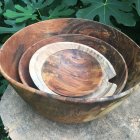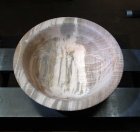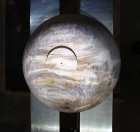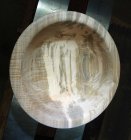-
Beware of Counterfeit Woodturning Tools (click here for details) -
Johnathan Silwones is starting a new AAW chapter, Southern Alleghenies Woodturners, in Johnstown, PA. (click here for details) -
Congratulations to Jim Hills for "Journey II" being selected as Turning of the Week for May 6th, 2024 (click here for details) -
Welcome new registering member. Your username must be your real First and Last name (for example: John Doe). "Screen names" and "handles" are not allowed and your registration will be deleted if you don't use your real name. Also, do not use all caps nor all lower case.
You are using an out of date browser. It may not display this or other websites correctly.
You should upgrade or use an alternative browser.
You should upgrade or use an alternative browser.
Don't know what it is
- Thread starter Ron Vasser
- Start date
- Joined
- Jan 27, 2005
- Messages
- 12,903
- Likes
- 5,193
- Location
- Dalworthington Gardens, TX
- Website
- pbase.com
Initially I thought that it might be figured soft maple that has a lot of spalting, but it seems to have a strong delineation between early and late wood which makes me think that it is something else. A closer examination would be needed to make a positive identification. Most wood species can be identified by closely examining the end grain under about 10X magnification. "Identifying Wood" by Bruce Hoadley is an excellent reference book for woodturners. If you can take macro shots with your camera, a sharply focused close up image of a clean slice across the end grain that shows the arrangement and size of the pores might help identify the wood.
It almost looks like a graft area with the differing grain.
Can you get us a pic of the bark? I am thinking maybe popcorn tree has the same wide area spalt but not as heavy a grain line
Looks like curly maple with a good mineral stain to it.
Could be sycamore. I got some beautiful sycamore that looked very similar to yours. The tree was identified by the homeowner where I got the wood. I’ve had several people tell me it isn’t sycamore because it is so dark, but the tree seems to be discolored by disease. The finished pieces have walnut oil and have a much darker tone. It also warps a lot. 

- Joined
- Jan 27, 2005
- Messages
- 12,903
- Likes
- 5,193
- Location
- Dalworthington Gardens, TX
- Website
- pbase.com
I'm wondering if the bright white areas might be white rot or maybe just doesn't have the blue stain or mold ... hard to tell which from the picture. Sometimes I just call it FOG wood (Found On Ground).
The white looks similar in pattern and color to rot I found on some Apple I have. Not suggesting the wood is Apple, just that the type of rot (if that is what it is) looks similar.
Not bad for something that was destined to be mulched! I would be going back for the rest of it too...But I like it. I got this at the county tree dump and green turned ten bowls from 10-11 inches diameter and 5-6 inches deep. I've got the end grain sealed and in paper bags. I'm going back tomorrow and get the rest of this tree. There is a 10 ' x 25" log still there. Any ideas what it might be?
View attachment 29367 View attachment 29368 View attachment 29369
Free wood is the best wood. I'm curious, too.
No clue... First thought was Persian/English Walnut because of the colors, but the pictures don't look like that... Some times you can tell from the smell of the wood, any scent?
Guy, I haven't seen sycamore that color, looks more like apple. Main way to tell sycamore is from the strong medullary rays when quarter sawn. I don't see any hint of that in those pieces, but if you cut the log in half, down the pith, it would be very clear.
robo hippy
Guy, I haven't seen sycamore that color, looks more like apple. Main way to tell sycamore is from the strong medullary rays when quarter sawn. I don't see any hint of that in those pieces, but if you cut the log in half, down the pith, it would be very clear.
robo hippy
Looks like maple to me. Take a close look at the tree limbs when you go back. If the limbs have alternate branching then it's not a maple tree, but if the branching is opposite then there's a very good chance this is maple wood. Also, see if you can find any leaves from this tree.
Initially I thought that it might be figured soft maple that has a lot of spalting, but it seems to have a strong delineation between early and late wood which makes me think that it is something else. A closer examination would be needed to make a positive identification. Most wood species can be identified by closely examining the end grain under about 10X magnification. "Identifying Wood" by Bruce Hoadley is an excellent reference book for woodturners. If you can take macro shots with your camera, a sharply focused close up image of a clean slice across the end grain that shows the arrangement and size of the pores might help identify the wood.
Looks like maple to me. Take a close look at the tree limbs when you go back. If the limbs have alternate branching then it's not a maple tree, but if the branching is opposite then there's a very good chance this is maple wood. Also, see if you can find any leaves from this tree.
Bill and Karl, you guys are correct. No leaves or limbs around where this log was located but the guy that takes care of the county tree work told me it is soft maple. Thanks for looking and replying!
The log has been pushed back but for a small tip the guy on the huge end loader will get it out for me in the morning. I'm glad it's still there.
Bill, LOL, most of the wood I use is FOG wood, I just didn't know the name of it! Thanks!
Ron, it's pretty warm & humid right now so don't be surprised if this maple starts growing mold if put in a bag too soon.
As a learning exercise, try soaking one of the rough turned bowls in a tightly sealed container of DNA (De-Natured Alcohol) for a couple of days in order to speed up drying and lessen the chance of cracking. Then see how the DNA bowl compares to the sealed/bagged bowl in order to know when it's worth the cost for using DNA. I mostly dry rough blanks using a small homemade kiln when there's a lot to dry one time, but so far the DNA I've tried on cherry bowls has really helped (retains a cherry color better, no mold issues & lowers chance of cracking).
Btw, another commonly used acronym is 'FORD' wood as in "Found On the Road Dead".
As a learning exercise, try soaking one of the rough turned bowls in a tightly sealed container of DNA (De-Natured Alcohol) for a couple of days in order to speed up drying and lessen the chance of cracking. Then see how the DNA bowl compares to the sealed/bagged bowl in order to know when it's worth the cost for using DNA. I mostly dry rough blanks using a small homemade kiln when there's a lot to dry one time, but so far the DNA I've tried on cherry bowls has really helped (retains a cherry color better, no mold issues & lowers chance of cracking).
Btw, another commonly used acronym is 'FORD' wood as in "Found On the Road Dead".
Ron, it's pretty warm & humid right now so don't be surprised if this maple starts growing mold if put in a bag too soon.
As a learning exercise, try soaking one of the rough turned bowls in a tightly sealed container of DNA (De-Natured Alcohol) for a couple of days in order to speed up drying and lessen the chance of cracking. Then see how the DNA bowl compares to the sealed/bagged bowl in order to know when it's worth the cost for using DNA. I mostly dry rough blanks using a small homemade kiln when there's a lot to dry one time, but so far the DNA I've tried on cherry bowls has really helped (retains a cherry color better, no mold issues & lowers chance of cracking).
Btw, another commonly used acronym is 'FORD' wood as in "Found On the Road Dead".
Thanks, Karl for the info. What temp and is there air movement in your homemade kiln?
My kiln is a simple insulated wooden crate (approximate 3' wide by 6' high by 1.5' deep) with heat lamps at the bottom and two vents at the top. I try to let my rough woodturnings harden off by dry slowly for several days before opening two tops vents to let some of the moisture escape. The temp fluctuates too much depending on outside temp so my plan to install a temp & humidity controller later this year.
Here's a couple of related pdf files you might want to check out:
baltimoreareaturners.org/articles/bowldryingkiln.pdf
http://www.cindydrozda.com/handouts_Pdfs/handouts/demo handouts/drying_kiln.pdf
Here's a couple of related pdf files you might want to check out:
baltimoreareaturners.org/articles/bowldryingkiln.pdf
http://www.cindydrozda.com/handouts_Pdfs/handouts/demo handouts/drying_kiln.pdf
Thanks, Karl, I've got something that will probably work. I built a 2'x4' egg incubator several years ago when we were hatching chickens and waterfowl but I haven't used it in a while. It has a controller that regulates the temp to 1/10 °, bottom vents to regulate incoming air, and top vents to regulate outgoing air an humidity. I'll go weigh some bowls and start experimenting tonight.
This is a link to the cheap controller that I've used for several years. You can run a computer fan to eliminate warm and cool spots.
https://www.amazon.com/WILLHI-WH143...1559169894&s=gateway&sr=8-1-spell-spons&psc=1
This is a link to the cheap controller that I've used for several years. You can run a computer fan to eliminate warm and cool spots.
https://www.amazon.com/WILLHI-WH143...1559169894&s=gateway&sr=8-1-spell-spons&psc=1
- Joined
- Jan 27, 2005
- Messages
- 12,903
- Likes
- 5,193
- Location
- Dalworthington Gardens, TX
- Website
- pbase.com
Thanks, Karl, I've got something that will probably work. I built a 2'x4' egg incubator several years ago when we were hatching chickens and waterfowl but I haven't used it in a while. It has a controller that regulates the temp to 1/10 °, bottom vents to regulate incoming air, and top vents to regulate outgoing air an humidity. I'll go weigh some bowls and start experimenting tonight.
This is a link to the cheap controller that I've used for several years. You can run a computer fan to eliminate warm and cool spots.
https://www.amazon.com/WILLHI-WH143...1559169894&s=gateway&sr=8-1-spell-spons&psc=1
Ron, what works best for you depends on your local climate. Most of the turners in Hawaii have to use a kiln or else the wood would never dry. The weather along the Gulf Coast is also very humid so a kiln might be called for. Here in north Texas a kiln would most likely cause the wood to dry too fast and split. For areas where high humidity isn't an obstacle to drying the approach is usually to keep the wood from drying too fast and splitting. Here in north Texas my process is to liberally coat the ends of logs with Anchorseal. When I rough turn green wood, I coat the entire piece with Anchorseal. After about four or five months these pieces are usually ready for final turning. If in doubt, I weigh the piece and then weigh it again a week or two later. If it's still losing weight, I'll wait and then check the weight after another week or two. It's not necessary to wait until the weight loss is zero. After gaining a little experience I can now tell when a piece is "dry enough" to do the final turning or sometimes the "almost but not quite final" intermediate turning.
If you go to Google Map Street View you can visit the address where the tree was cut down and look at the tree before it was cut down.
This will provide a view of the tree shape, bark and leaf structure which is usually enough to come to an educated guess.
This will provide a view of the tree shape, bark and leaf structure which is usually enough to come to an educated guess.
I have found with maples around here, if I turn them right away, the colors are bright and shiny. If I let them sit for a month or so, they do rather dull. I figure it is all the sugar in the maples, and those things that turn nice wood into compost get a head start on the maple trees....
robo hippy
robo hippy
John Jordan
In Memorium
- Joined
- Jun 24, 2008
- Messages
- 506
- Likes
- 965
- Location
- Cane Ridge (Nashville), TN
- Website
- www.johnjordanwoodturning.com
Red Maple-acer rubrum. The same wood as "ambrosia maple". Take it to the bank. 
John
John



